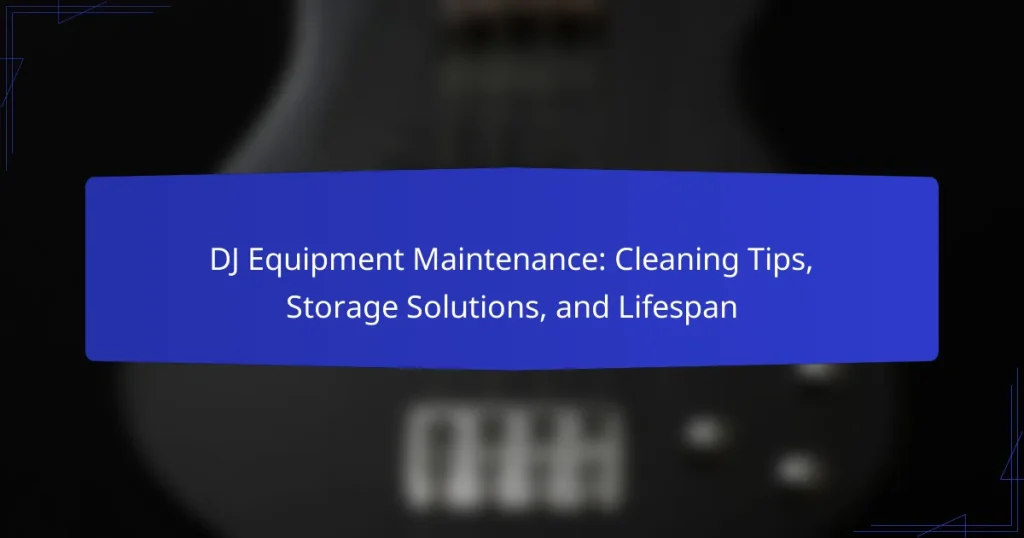DJ equipment maintenance encompasses the regular care and upkeep of essential gear such as mixers, turntables, and speakers to ensure optimal performance and longevity. This article outlines effective cleaning techniques, safe storage solutions, and factors influencing the lifespan of DJ equipment, which typically ranges from 5 to 10 years. Key maintenance practices include dusting surfaces, inspecting cables, and using appropriate storage cases to protect against damage. By following manufacturer guidelines and implementing proper care, DJs can enhance sound quality and prolong the life of their equipment.
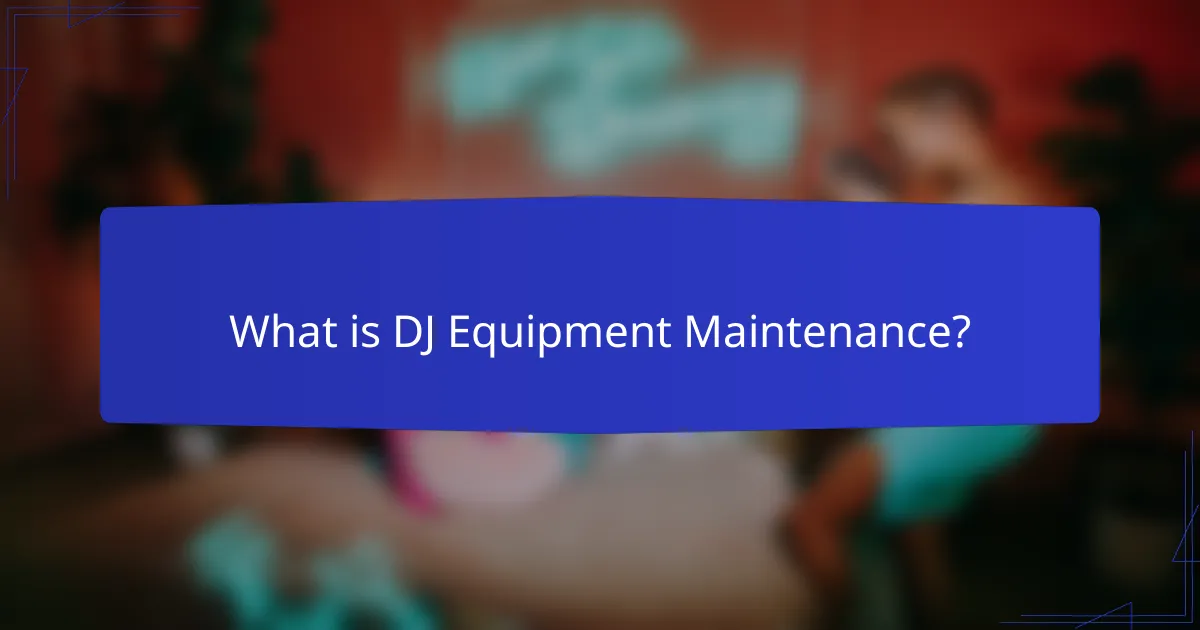
What is DJ Equipment Maintenance?
DJ equipment maintenance refers to the regular care and upkeep of DJ gear to ensure optimal performance. This includes cleaning, inspecting, and repairing equipment such as mixers, turntables, and speakers. Proper maintenance helps prolong the lifespan of the equipment and enhances sound quality. Regular cleaning prevents dust and grime buildup, which can affect performance. Inspecting cables and connections ensures reliable operation during performances. Additionally, storing equipment in a safe environment protects it from damage. Following manufacturer guidelines also contributes to effective maintenance.
Why is regular maintenance important for DJ equipment?
Regular maintenance is important for DJ equipment to ensure optimal performance and longevity. Proper upkeep prevents malfunctions during performances. Dust and debris can accumulate, affecting sound quality. Regular cleaning helps maintain the integrity of the equipment. Additionally, checking connections and cables reduces the risk of damage. Regular maintenance can extend the lifespan of components, saving costs on replacements. Statistics show that well-maintained equipment can last significantly longer than neglected items. For instance, routine servicing can increase the lifespan of mixers and turntables by up to 30%.
What are the potential consequences of neglecting maintenance?
Neglecting maintenance of DJ equipment can lead to significant operational issues. Equipment may experience decreased performance over time. This can result in poor sound quality during performances. Additionally, neglected equipment is more prone to breakdowns and malfunctions. Such failures can lead to costly repairs or replacements. Regular maintenance is crucial to prolong the lifespan of the equipment. For example, cleaning components can prevent dust buildup that affects functionality. Statistics show that well-maintained equipment can last up to 30% longer than neglected gear.
How does maintenance extend the lifespan of DJ equipment?
Regular maintenance extends the lifespan of DJ equipment by preventing wear and tear. Cleaning components removes dust and debris that can cause damage. Proper storage protects equipment from environmental factors like moisture and temperature fluctuations. Regularly checking connections ensures reliable performance and prevents malfunctions. Scheduled servicing can identify and fix issues before they become serious. According to a study by the Audio Engineering Society, routine maintenance can increase the lifespan of electronic devices by up to 30%. Thus, consistent maintenance is essential for durability and optimal performance.
What are the key components of DJ equipment that require maintenance?
The key components of DJ equipment that require maintenance include turntables, mixers, headphones, and speakers. Turntables need regular cleaning of the platter and stylus to ensure sound quality. Mixers require dusting and cleaning of knobs and faders to maintain functionality. Headphones should be checked for cable wear and ear pad condition regularly. Speakers need to be inspected for dust accumulation and driver integrity to ensure optimal performance. Regular maintenance of these components prolongs their lifespan and enhances overall performance.
How should turntables be maintained for optimal performance?
Turntables should be maintained by regularly cleaning the components and ensuring proper setup. Dust and debris can affect sound quality and performance. Use a microfiber cloth to clean the platter and tonearm. This prevents buildup that can interfere with playback. Check and replace the stylus as needed. A worn stylus can damage records and degrade sound quality. Ensure the turntable is level to avoid tracking issues. An unlevel turntable can cause uneven wear on the stylus. Additionally, store the turntable in a dry environment to prevent moisture damage. Proper maintenance extends the lifespan and enhances the performance of the turntable.
What cleaning practices are essential for mixers and controllers?
Essential cleaning practices for mixers and controllers include regular dusting, proper sanitization, and careful handling. Dusting prevents buildup that can affect performance. Use a microfiber cloth to gently wipe surfaces. For sanitization, use isopropyl alcohol on a cloth to clean knobs and faders. Avoid direct application of liquids to prevent damage. Additionally, ensure that connectors and ports are free from debris. Regular maintenance extends the lifespan of the equipment. Following these practices helps maintain optimal functionality and appearance.
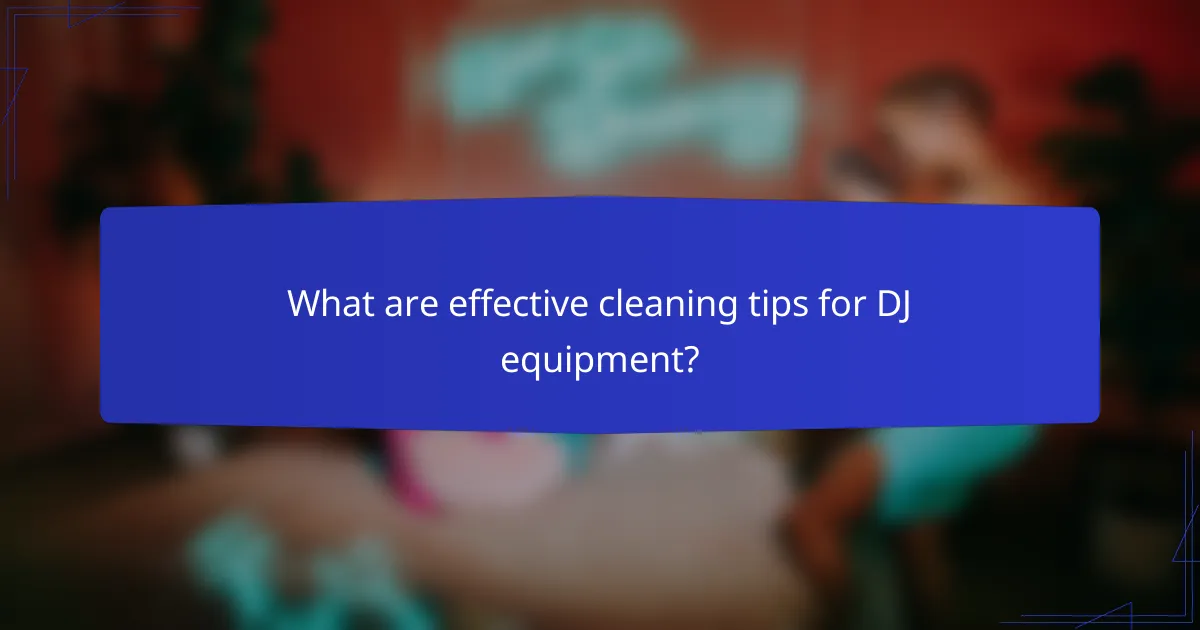
What are effective cleaning tips for DJ equipment?
To effectively clean DJ equipment, start by unplugging all devices to ensure safety. Use a microfiber cloth to dust surfaces gently. For stubborn grime, slightly dampen the cloth with water or a specialized electronics cleaner. Avoid using harsh chemicals that can damage components. Clean knobs and sliders with a soft brush to remove dirt buildup. Use compressed air to blow dust out of crevices and ports. Wipe down cables with a dry cloth to prevent corrosion. Regular cleaning can extend the lifespan of your equipment and maintain optimal performance.
How can you safely clean different types of DJ gear?
To safely clean different types of DJ gear, use appropriate cleaning methods for each type. For turntables, use a microfiber cloth to wipe down surfaces and avoid excess moisture. Clean the stylus with a specialized brush to prevent damage. For mixers, disconnect power and use a damp cloth for exterior surfaces. Avoid getting moisture into the faders and knobs. For headphones, remove ear pads and clean with a gentle soap solution. Rinse and dry thoroughly before reassembling. For CDJs and controllers, use a soft cloth and mild cleaner, ensuring no liquid enters the device. Regular maintenance extends the lifespan of DJ gear and maintains performance.
What cleaning agents are safe for use on DJ equipment?
Isopropyl alcohol and microfiber cloths are safe cleaning agents for DJ equipment. Isopropyl alcohol effectively removes grime and residue without damaging electronics. Microfiber cloths prevent scratching while cleaning surfaces. Avoid using ammonia-based cleaners as they can harm sensitive components. Always ensure equipment is powered off before cleaning. Regular maintenance prolongs the lifespan of DJ gear.
How often should cleaning be performed on various components?
Cleaning should be performed on various DJ equipment components regularly. For surfaces like mixers and turntables, clean them after every use to prevent dust accumulation. Cables should be inspected and wiped down monthly to ensure optimal performance. Headphones require cleaning every few uses, especially the ear pads, to maintain hygiene. Speakers should be dusted weekly to preserve sound quality. Additionally, filters in amplifiers should be cleaned every three months to prevent overheating. Regular cleaning extends the lifespan of equipment and enhances performance.
What are the best practices for maintaining cables and accessories?
Regularly inspect cables and accessories for wear and damage. Look for frayed wires, loose connectors, and signs of corrosion. Clean cables with a damp cloth to remove dirt and grime. Avoid using harsh chemicals that can degrade materials. Store cables coiled loosely to prevent kinks and tangles. Use cable ties or organizers to keep them neat. Keep accessories in a dry, cool place to prevent moisture damage. Label cables for easy identification and organization. These practices can extend the lifespan of your DJ equipment and ensure optimal performance.
How should cables be stored to prevent damage?
Cables should be stored in a coiled manner to prevent damage. Coiling prevents kinks and tangles that can compromise cable integrity. Use cable ties or Velcro straps to secure coiled cables. This keeps them organized and reduces strain on connections. Store cables in a cool, dry place to avoid moisture damage. Avoid placing heavy objects on top of stored cables. This can lead to physical damage over time. Using a dedicated cable organizer can also enhance protection. Proper storage extends the lifespan of cables significantly.
What routine checks should be performed on accessories?
Routine checks on accessories should include inspecting cables for frays or damage. Ensure connectors are clean and free from corrosion. Test audio quality through each accessory to confirm functionality. Check for loose screws or fittings on devices. Verify that battery-powered accessories have fresh batteries. Clean surfaces to prevent dust buildup. Assess any software updates for digital accessories. Confirm that all accessories are stored properly to avoid physical damage.
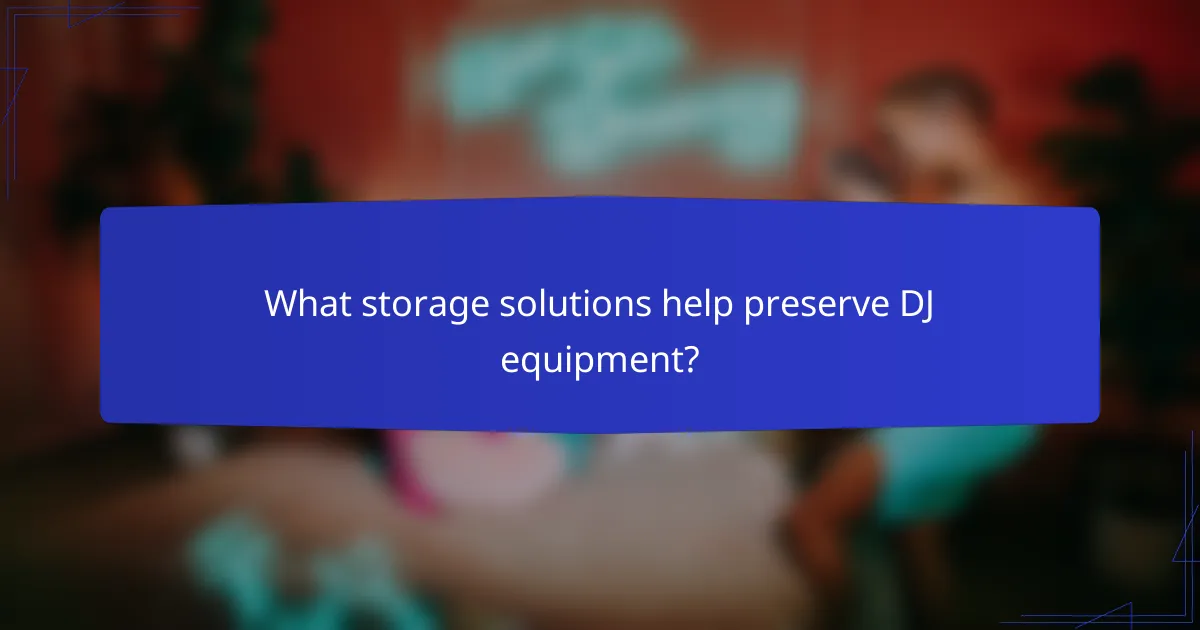
What storage solutions help preserve DJ equipment?
Hard cases are effective storage solutions that help preserve DJ equipment. They provide protection against physical damage and environmental factors. Soft cases offer lightweight alternatives, but may not offer the same level of protection. Rackmount cases are useful for organizing and securing multiple pieces of gear. Climate-controlled storage environments prevent moisture and temperature fluctuations that can damage electronics. Foam inserts within cases can prevent movement and impact during transport. Proper labeling of cases aids in quick identification and organization. These methods collectively extend the lifespan of DJ equipment and maintain its functionality.
How should DJ equipment be stored when not in use?
DJ equipment should be stored in a cool, dry place when not in use. This prevents moisture damage and overheating. Use padded cases or bags for protection against physical damage. Ensure that all components are unplugged to avoid electrical issues. Keep the equipment away from direct sunlight to prevent fading and warping. Store in a dust-free environment to avoid buildup that can affect performance. Regularly check and maintain the equipment during storage to ensure functionality. Proper storage extends the lifespan of DJ equipment significantly.
What types of cases or bags are best for DJ gear?
Soft cases, hard cases, and backpacks are the best types of bags for DJ gear. Soft cases provide lightweight protection and easy transport. They are often padded to safeguard equipment from minor impacts. Hard cases offer maximum protection against drops and environmental factors. They are typically made of durable materials like plastic or aluminum. Backpacks are convenient for carrying essential gear hands-free. They often include compartments for organization and quick access. Selecting the right case or bag depends on the type of gear and travel requirements.
How does climate affect the storage of DJ equipment?
Climate significantly affects the storage of DJ equipment. High humidity can lead to moisture buildup, causing damage to electronic components. This moisture can result in corrosion and malfunction of sensitive parts. Low temperatures can make materials brittle, increasing the risk of breakage. Additionally, extreme temperatures can affect battery performance and lifespan. UV exposure from sunlight can degrade plastic and rubber components over time. Proper climate-controlled storage is essential to prolong the life of DJ equipment. Storing equipment in a stable environment reduces the risk of damage from these climate-related factors.
What organization strategies can enhance equipment longevity?
Implementing regular maintenance schedules enhances equipment longevity. Regular inspections can identify wear and tear early. Cleaning equipment after each use prevents dust buildup. Proper storage in a controlled environment protects against humidity and temperature fluctuations. Using protective cases minimizes physical damage during transport. Training staff on proper handling techniques reduces accidental damage. Keeping an inventory of equipment helps track usage and maintenance needs. Following manufacturer guidelines ensures optimal performance and longevity.
How can you create an efficient setup for easy access and maintenance?
To create an efficient setup for easy access and maintenance of DJ equipment, organize your workspace methodically. Use labeled storage bins for each type of equipment. This allows for quick identification and retrieval. Keep frequently used items within arm’s reach. Position them on shelves or in drawers that are easily accessible.
Utilize cable management solutions to prevent tangling. This also ensures safety and ease of setup. Regularly clean your equipment to maintain performance. Establish a routine maintenance schedule to check for wear and tear. This proactive approach extends the lifespan of your gear.
According to a study by the Audio Engineering Society, proper organization can reduce setup time by up to 30%. This emphasizes the importance of an efficient setup for both access and maintenance.
What labeling systems can help in managing equipment and accessories?
Color-coded labeling systems can help in managing equipment and accessories. These systems use different colors to categorize items for easy identification. For example, red labels can indicate high-priority equipment. Green labels can denote accessories that are frequently used. QR code labeling systems also enhance management efficiency. They allow for quick access to information about each item via a smartphone scan. Labeling software can assist in creating custom labels, ensuring clarity and organization. Proper labeling minimizes the risk of misplacing equipment and accessories. Studies show that organized labeling can improve workflow efficiency by up to 30%.
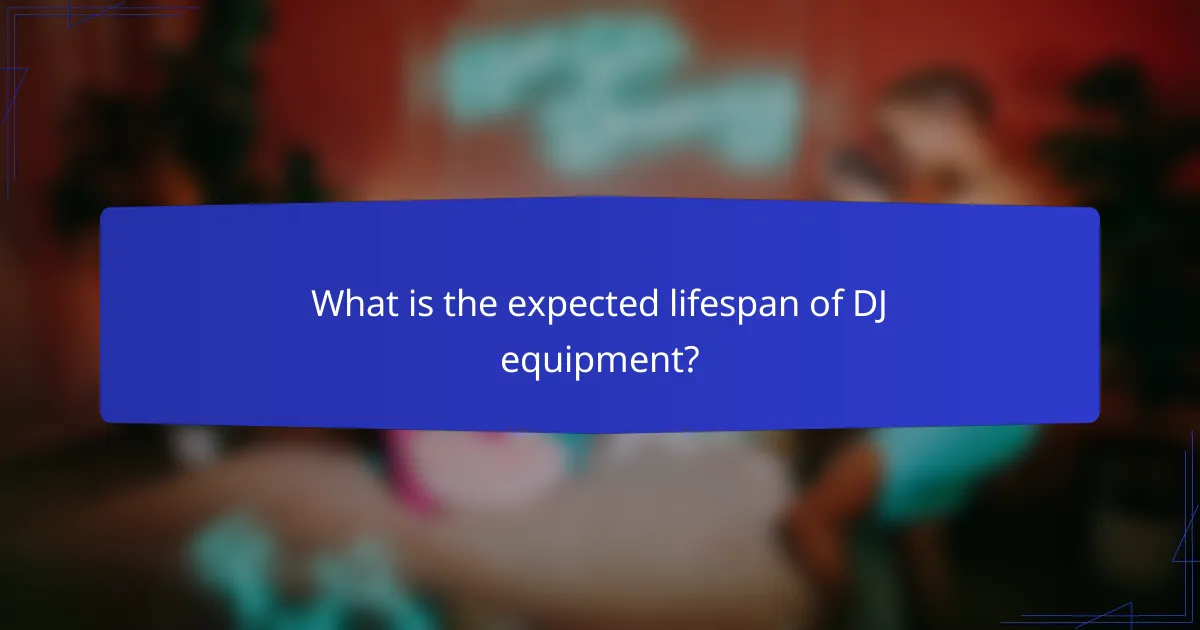
What is the expected lifespan of DJ equipment?
The expected lifespan of DJ equipment typically ranges from 5 to 10 years. Factors influencing this lifespan include the quality of the equipment and usage frequency. High-end gear may last longer due to superior materials and construction. Regular maintenance can also extend the lifespan. For instance, cleaning and proper storage significantly reduce wear and tear. Additionally, technological advancements may prompt upgrades before equipment fails. Thus, while the average lifespan is 5 to 10 years, individual experiences may vary based on care and usage.
How does usage frequency impact the lifespan of DJ gear?
Usage frequency directly affects the lifespan of DJ gear. Higher usage typically leads to increased wear and tear on components. For example, frequent use of turntables can result in motor strain and cartridge degradation. Similarly, mixers may experience more frequent knob and fader wear. According to a study by the Audio Engineering Society, equipment used daily can have a lifespan reduced by up to 30%. Conversely, gear used less often tends to maintain its functionality longer. Regular maintenance can mitigate some effects of frequent use. However, no amount of care can fully counteract the impact of high usage. Thus, frequency of use is a critical factor in determining DJ gear longevity.
What are the signs that indicate equipment needs replacement?
Signs that indicate equipment needs replacement include frequent malfunctions, diminished performance, and visible wear and tear. Equipment that consistently breaks down during use is a clear indicator of its declining reliability. Reduced sound quality or output levels can signal that components are failing. Additionally, if equipment shows physical damage such as cracks or corrosion, it may no longer function safely or effectively. Age is also a factor; older equipment may not meet current technological standards. Regular maintenance checks can help identify these signs early. Addressing these issues promptly can prevent further damage and ensure optimal performance.
How can proper maintenance influence the longevity of specific components?
Proper maintenance significantly enhances the longevity of specific components in DJ equipment. Regular cleaning prevents dust and grime buildup, which can impair functionality. For instance, maintaining clean connections can reduce signal loss, ensuring better sound quality. Additionally, proper storage protects components from environmental factors like humidity and temperature fluctuations. Routine checks for wear and tear can identify issues before they escalate into costly repairs. Research indicates that equipment longevity can increase by up to 30% with consistent maintenance practices. Following manufacturer guidelines also ensures optimal performance and lifespan.
What are common troubleshooting tips for DJ equipment maintenance?
Common troubleshooting tips for DJ equipment maintenance include checking cables for damage, ensuring connections are secure, and inspecting power sources. Cables can fray or break, leading to audio issues. Loose connections may cause intermittent sound problems. Power sources should be stable to avoid equipment malfunction. Regularly cleaning equipment, including faders and knobs, helps maintain functionality. Dust and debris can affect performance. Testing equipment before events ensures everything operates correctly. Keeping firmware updated can prevent compatibility issues. These practices help prolong the lifespan of DJ equipment and ensure reliable performance.
How can you identify and resolve common issues with DJ gear?
To identify and resolve common issues with DJ gear, start by checking for power supply problems. Ensure all cables are connected securely and that the power source is functioning. Next, inspect audio connections for any loose or damaged cables. Replace any faulty cables to restore sound quality. If the equipment is not responding, perform a reset according to the manufacturer’s guidelines. Additionally, look for software updates that may resolve performance issues. Regularly clean the gear to prevent dust buildup, which can affect functionality. Use appropriate cleaning materials to avoid damage. Lastly, consult the user manual for troubleshooting tips specific to your equipment model.
What resources are available for learning more about equipment care?
Online courses and tutorials are available for learning about equipment care. Websites like Udemy and Skillshare offer specific courses on equipment maintenance. YouTube hosts numerous channels dedicated to DJ equipment care and maintenance tips. Manufacturer websites often provide manuals and care guides for their products. Forums and communities, such as DJ TechTools, share user experiences and advice on equipment upkeep. Books on audio equipment maintenance can also be found through online retailers. These resources collectively provide comprehensive knowledge for proper equipment care.
DJ equipment maintenance encompasses the essential practices of cleaning, inspecting, and repairing gear like mixers, turntables, and speakers to ensure optimal performance and longevity. Regular maintenance prevents malfunctions, enhances sound quality, and extends the lifespan of equipment by up to 30%. Key components requiring attention include turntables, mixers, headphones, and speakers, each with specific cleaning and maintenance protocols. Effective storage solutions and organization strategies further protect equipment from damage while promoting efficient access and care. The article provides detailed insights into cleaning practices, maintenance schedules, and troubleshooting tips for DJs to maximize the performance and durability of their gear.
